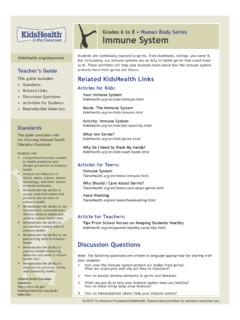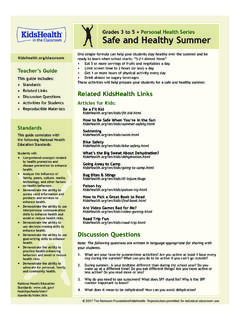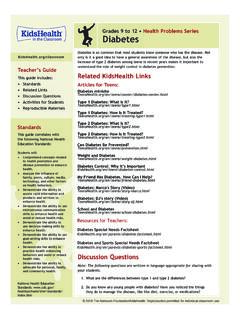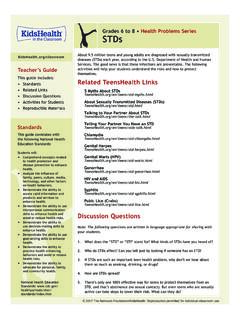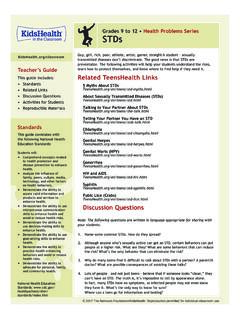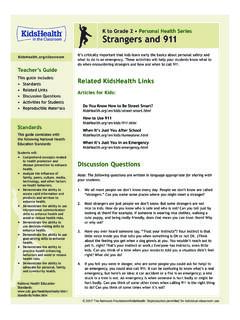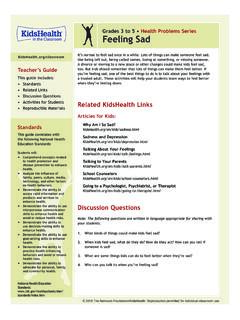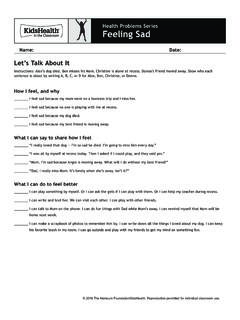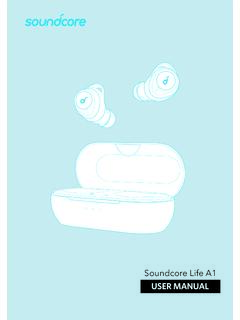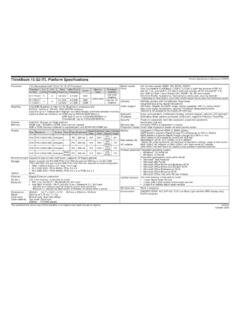Transcription of Teacher's Guide: Hearing (Grades 3 to 5) - KidsHealth
1 2017 The Nemours Foundation/ KidsHealth . Reproduction permitted for individual classroom 3 to 5 Human Body SeriesHearingWe listen to sounds and interpret their meanings all day, but how does your body do it? These activities will help your students understand their sense of Hearing and learn how to protect their KidsHealth LinksArticles for K ids:Discussion QuestionsNote: The following questions are written in language appropriate for sharing with your parts of our bodies help us to hear and understand sound? kinds of things can damage your Hearing ? What causes Hearing loss forsome people? some kinds of sounds you like. Name some sounds that get on yournerves. Why do you think some noises appeal to you more than others? are some ways you can take care of your ears?
2 5. Are you listening? is a common question teachers ask. But are listening andhearing the same thing? do your ears do beside help you hear?Teacher s GuideThis guide includes: Standards Related Links Discussion Questions Activities for Students Reproducible MaterialsStandardsThis guide correlates with the following National Health Education Standards:Students will: Comprehend concepts relatedto health promotion anddisease prevention to enhancehealth. Analyze the influence offamily, peers, culture, media,technology, and other factorson health behaviors. Demonstrate the ability toaccess valid information andproducts and services toenhance health. Demonstrate the ability to useinterpersonal communicationskills to enhance health andavoid or reduce health risks. Demonstrate the ability touse decision-making skills toenhance health.
3 Demonstrate the ability to usegoal-setting skills to enhancehealth. Demonstrate the ability topractice health-enhancingbehaviors and avoid or reducehealth risks. Demonstrate the ability toadvocate for personal, family,and community Health EducationStandards: Needs Factsheet for Teachers: Hearing Impairments : Ears Ears : Care of Your Ears What s Hearing Loss? Loud Music Hurt My Ears? Is an Ear Infection? What s Earwax? Swimmer s Ear Going to the Audiologist Experiment: Do You Hear What I Hear? Experiment: Model Eardrum 2017 The Nemours Foundation/ KidsHealth . Reproduction permitted for individual classroom for StudentsNote: The following activities are written in language appropriate for sharing with your Ins and Outs of Your EarsObjectives:Students will: Explore their sense of Hearing Learn the parts of the ear and how ears transmit soundMaterials: Computer with Internet access The Ins and Outs of Your Ears handoutClass Time: 1 hourActivity:Just like a storybook, your ears have three parts: a beginning, middle, and end.
4 These parts are called the outer ear, the middle ear, and the inner ear, and each part has a specific function. To find out more about how your ears detect and interpret sounds, read the articles related to Hearing , then take the online quiz on ears ( ) to see how much you learned. Next, label a diagram of the ear on The Ins and Outs of Your Ears handout. students read the articles about Hearing , then create posters for the classroom or hallwayspromoting safety tips related to their ears and the two Senses Experiments related to Hearing and write down the next time you re in a pool, put your head under the water and listen to how things sound different. Trysnapping your fingers out of the water, then underwater. Try tapping the ladder. Try talking to someone.
5 Discusshow traveling through air or water affects sounds we how bats, dolphins, whales, and other animals use echolocation to hear what s around them. Thenchoose one animal and write a brief report explaining how it uses 3 to 5 Human Body SeriesHearing 2017 The Nemours Foundation/ KidsHealth . Reproduction permitted for individual classroom is devoted to providing the latest children s health information. The site, which is widely recommended by educators, libraries, and school associations, has received the Teachers Choice Award for the Family and the prestigious Pirelli Award for Best Educational Media for Students. KidsHealth comes from the nonprofit Nemours Foundation. Check out to see the latest additions!Sounds of SilenceObjectives:Students will: Identify everyday sounds and background noises Compare indoor sounds and outdoor soundsMaterials: Paper, pencil or penClass Time: 30 minutesActivity:What does silence sound like?
6 Is there a place or time when there is absolutely no sound? What are background noises? Let s investigate. First, let s be quiet for 2 minutes. Put your head down and really listen to the sounds of a quiet classroom. Now, without making a sound, jot down every noise you heard in the 2 minutes. What does a quiet classroom sound like? What background noises do we hear now that usually are drowned out by voices and other activities in class? When everyone is done, we ll share your findings. Now let s do the same activity outside. For the next 5 minutes, silently jot down all of the sounds you hear, then we ll compare notes. How does your brain figure out which sounds to listen to and which ones to drown out? 5 minutes before you go to sleep tonight, listen to all of the sounds you hear inside and outside.
7 When youwake up, do the same thing. Are the sounds the same or different? Hearing -impaired kids use sign language to communicate. Check out books or online resources on AmericanSign Language (ASL) and learn a few MaterialsHandout: The Ins and Outs of Your Ears : The Ins and Outs of Your Ears : Hearing Key: Hearing 3 to 5 Human Body SeriesHearing 2017 The Nemours Foundation/ KidsHealth . Reproduction permitted for individual classroom : Date:Human Body SeriesHearingIns and Outs of Your EarsDirections: Label the ear, referring to the article Your Ears. 2017 The Nemours Foundation/ KidsHealth . Reproduction permitted for individual classroom Body SeriesHearingIns and Outs of Your Ears Answer KeyAuricleEar canalEardrumHammer (malleus) Anvil(incus)Stirrup (stapes)CochleaEustachian tube 2017 The Nemours Foundation/ KidsHealth .
8 Reproduction permitted for individual classroom : Date:Human Body SeriesHearingQuizInstructions: Answer each and process signals to your you keep your of the or false: Earwax contains chemicals that fight off infections (germs) that could hurt the skin inside the ear or false: People who are exposed to loud noises over long periods of time might lose their Hearing or false: Listening to loud music using earbuds can damage your in the blanks using the Word Bank at the bottom of the page: The main job of the outer ear is to collect . The middle ear takes sound and turns them into that are delivered to the inner ear. When sound reaches the inner ear, the vibrations (sounds) cause tiny on the cells to move, creating signals that the understands as sound.
9 The brain puts it all together and that s how you hear and process sounds. brain hairs nerve sound vibrations wavesWord Bank 2017 The Nemours Foundation/ KidsHealth . Reproduction permitted for individual classroom Body SeriesHearingQuiz Answer ears:a. collect and process soundsb. send signals to your brainc. help you keep your of the or false: Earwax contains chemicals that fight off infections (germs) that could hurt the skin inside the ear or false: People who are exposed to loud noises over long periods of time might lose their Hearing or false: Listening to loud music using earbuds can damage your in the blanks using the word bank at the bottom of the page:The main job of the outer ear is to collect sound.
10 The middle ear takes sound waves and turns them into vibrations that are delivered to the inner ear. When sound reaches the inner ear, the vibrations (sounds) cause tiny hairs on the cells to move, creating nerve signals that the brain understands as sound. The brain puts it all together and that s how you hear and process sounds. brain hairs nerve sound vibrations wavesWord Bank
